National drayage carrier copes with congestion with technology and a focus on customers and drivers.
With terminals clogged and the supply chain snarled, it’s not surprising that congestion has put the entire drayage industry under enormous pressure. Cargo receivers are detaining equipment for longer periods of time—and drayage carriers get hit with the charges. The carriers pass those costs on to customers, along with increased rates bought on by tight capacity, but the situation represents a significant cash outlay for the dray carriers.
“High demand and tight driver capacity remain the theme in the drayage market,” noted XPO Logistics, in a recent Intermodal Market Update.
ContainerPort Group (CPG), a drayage carrier with 25 terminals along the United States Eastern seaboard, along the Gulf Coast, and at inland rail terminals, has “felt that pressure,” said Joey Palmer, the company’s recently-named president. “We have seen congestion at marine and rail terminals and chassis availability issues at every location.” Increased equipment dwell time has come as a “direct result of supply-chain congestion,” forcing the carrier to incur “unprecedented increases in dwell-time costs.”
But, Palmer added, “We have performed incredibly well under the circumstances.”
Palmer attributes CPG’s performance to an increased level of communications, in the form of shipment updates, with customers. “We make sure that customers always have the latest on the status of their containers,” he said. “We have a primary focus of increasing communications at all touchpoints with customers throughout the organization.”
Another reason for CPG’s success, according to Palmer, has been the deployment of technology, which he said, are designed “to meet the needs of customers and drivers as well.” Recruiting and retaining experienced drivers has been yet another focus for the company.

The Digital Dray
The drayage industry has been increasingly deploying digital technologies that promote operations in a real-time environment. Experts note that drayage has lagged behind some other transportation segments in that regard, and Palmer acknowledged that it “hasn’t been as common in the past.”
CPG, which recently celebrated its 50th anniversary in business, has deployed technologies that include tracking and tracing of containers, chassis, and shipments, all which “help us to move faster,” said Palmer, “and ultimately deliver better performance to our customers.” CPG has also installed location-tracking GPS technology on all its equipment, electronic documentation systems, and in-cab cameras to support company safety goals.
Technology has also been proliferating elsewhere in the drayage industry, at the Port of Long Beach, for example, which announced recently that drayage truckers can now opt into a free system called Truck Alert to receive information, alerts, and updates about traffic conditions via text message. The system, said Mario Cordero, executive director of the Port of Long Beach, “is designed to reduce road congestion by providing truck drivers an opportunity to improve scheduling and enhance turn times.”
A New Jersey-based technology company, BookYourCargo (BYC), recently launched the cloud-based Digital Drayage Platform, featuring artificial intelligence and machine learning capabilities, to provide quotes and visibility. “There has never been a more important time to find efficiencies than right now,” said Nimesh Modi, BYC’s CEO, “with the surge of imports, shrinking capacity, and the lack of drivers creating drayage issues all over the world.”
Retaining Drivers
Modi also claims that “one of the most critical issues for drayage operations domestically is the exodus of drivers and the lack of any real pipeline to recruit and retain new ones.”
CPG believes that it is performing better than most in that department. “For us, our number-one priority is attracting and retaining an experienced driver base,” said Palmer. “It’s also the one thing that keeps me up at night.”
Palmer said CPG offers drivers “competitive rates, and we are working very hard to make sure drivers are fairly compensated. We’ve seen wages climb even though we’re dealing with unprecedented delays and congestion.”
Beyond compensation, Palmer said that CPG strives to “create experiences for drivers to make them want to stay with us.” “There are no magic bullets in that gun,” he added. “It’s hard work and it takes communications and creating experiences to retain drivers for the fleet.”
The driver experience CPG strives for mirrors its approach to customers. “It’s really about transparency and respect,” said Palmer. “”We let drivers know what we’re experiencing and what they can expect out of a day’s work. It’s important to have these conversations with drivers so they can be prepared.”
Expanding Terminals
CPG’s success in weathering the pandemic and its related congestion is reflected in its recent investments in business expansion. The company recently opened three new drayage terminals in what are new markets for CPG—Minneapolis, New Orleans, and Greer, South Carolina.
“These came in direct response to customer requests,” said Palmer. Greer is the site of a rapidly-growing inland port, and CPG is experiencing “rapid growth in that market.”
Minneapolis and New Orleans represent similar situations, with growth in cargo activity being experienced at those locations. “Some of our key customers approached us about adding capacity in those markets as they expanded their own networks,” said Palmer.
At the same time, CPG also announced earlier this year that it had sold its container yard operations at several Midwest locations to ITS ConGlobal LLC. But that, too, is a reflection of the company’s expansion and success.
“We used to be a Midwest and Northeast based carrier,” Palmer explained, and the operations that it sold supported activities in those regions. “As we expanded our footprint by becoming more of a national drayage provider, we had an opportunity to sell the depots to a company that is focused more on that segment of the business. We can focus more on trucking and logistics, which is what we really do best.”





